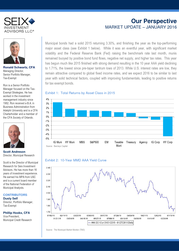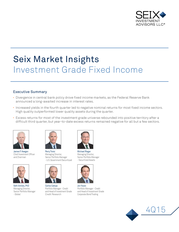Ridgeworth Insights: Leveraged Loan And High Yield Market Review 1Q16 - May 3, 2016
Seix Investment Advisors
Description
FIRST QUARTER 2016 | PAGE 4
ridgeworth.com | 866.595.2470
3333 Piedmont Road, NE
Suite 1500
A
tlanta, GA 30305
ABOUT RIDGEWORTH INVESTMENTS
RidgeWorth Investments—a global investment management firm headquartered in Atlanta, Georgia with approximately $37.9 billion
in assets under management as of March 31, 2016—offers investors access to a select group of boutique investment managers and
subadvisers. RidgeWorth wholly owns three boutiques: Ceredex Value Advisors LLC, Seix Investment Advisors LLC and Silvant Capital
Management LLC, and holds a minority ownership in Zevenbergen Capital Investments LLC. WCM Investment Management and Capital
Innovations, LLC serve as subadvisers to the RidgeWorth Funds. Through these six investment managers, RidgeWorth offers a wide variety
of fixed income and equity disciplines, providing investment management services to a growing client base that includes institutional,
individual and high net worth investors.
For more information about RidgeWorth, its boutiques and its subadvisers, visit ridgeworth.com.
ABOUT SEIX INVESTMENT ADVISORS LLC
Seix Investment Advisors, one of RidgeWorth’s investment management boutiques, has exclusively focused on managing fixed income
assets since 1992.
Seix seeks to generate competitive absolute and relative risk-adjusted returns over the full market cycle through a bottom-up focused, top-down aware process. Seix employs multi-dimensional approaches based on strict portfolio construction methodology, sell disciplines and trading strategies with prudent risk management as a cornerstone. For more information about Seix, visit seixadvisors.com. RFRI-LLOAN-0316 .
Seix seeks to generate competitive absolute and relative risk-adjusted returns over the full market cycle through a bottom-up focused, top-down aware process. Seix employs multi-dimensional approaches based on strict portfolio construction methodology, sell disciplines and trading strategies with prudent risk management as a cornerstone. For more information about Seix, visit seixadvisors.com. RFRI-LLOAN-0316 .









